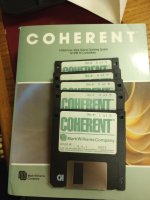alejack12001
Veteran Member
Has anyone ever tried to use Mark William's Coherent on a vintage machine?
| VCF West | Aug 01 - 02 2025, | CHM, Mountain View, CA |
| VCF Midwest | Sep 13 - 14 2025, | Schaumburg, IL |
| VCF Montreal | Jan 24 - 25, 2026, | RMC Saint Jean, Montreal, Canada |
| VCF SoCal | Feb 14 - 15, 2026, | Hotel Fera, Orange CA |
| VCF Southwest | May 29 - 31, 2026, | Westin Dallas Fort Worth Airport |
| VCF Southeast | June, 2026 | Atlanta, GA |
Yea I'm pretty sure Coherent processes are the "tiny" memory model, meaning combined 64K code/data per process.If I remember correctly Coherent binaries could only handle 64 KB.
I've given a fast look at the book, and it has some interesting things:Looks like (Coherent's Book) it's available here: http://www.bitsavers.org/pdf/markWilliams/Coherent_Revision_8_1992.pdf

Kind of being neck deep in the world of multi user business computing, I honestly didn't encounter actual TCP/IP networking until the mid- to late 90s.There are several pages out there about Coherent and the wisdom of MWC working on X11 instead of TCP/IP.
Any idea what happened to his site? It up and vanished. Disappointed to see that, but I have not heard anything (hardly means anything, not that I'm in any kind of loop). But he had a very nice CP/M site.Udo Munk had a page up about running Coherent on Virtualbox;
Yea I'm pretty sure Coherent processes are the "tiny" memory model, meaning combined 64K code/data per process.
Any idea what happened to his site? It up and vanished. Disappointed to see that, but I have not heard anything (hardly means anything, not that I'm in any kind of loop). But he had a very nice CP/M site.
Yea, I wasn't sure. The small model is more complicated. That is, if I get a pointer to a function and dereference it, do I get data from the code segment, or indeterminate data from the data segment that just so happens to be at the same offset.I think they actually have separate code/data pages for 128k, IE, “small” model?
I always wanted to try on my 286, but I only found 386+ versions. So I never tried except for a single VM experience. Would have been interesting, but I like TCP/IP connectivity...If I had a suitable 286 or better I’d probably want to try it once, but my strong impression is there’s not much you can actually do with it.
Does it matter? In C, you are only allowed to convert a pointer to an integer and back to a pointer of the same type - everything else is implementation-defined. Or in other words, if you call a function through that pointer, it's probably your code segment - if you memcpy from it, it's probably your data segment.That is, if I get a pointer to a function and dereference it, do I get data from the code segment, or indeterminate data from the data segment that just so happens to be at the same offset.
It matters if you're trying to inject executable code into your process.Does it matter?
I always wanted to try on my 286, but I only found 386+ versions. So I never tried except for a single VM experience. Would have been interesting, but I like TCP/IP connectivity...
Well, at the time I was using it the machine was not at all "vintage," but yes, it was my primary machine for a couple of years before I upgraded to Xenix 286.Has anyone ever tried to use Mark William's Coherent on a vintage machine?
For a '386 you'd be much better off running NetBSD (or FreeBSD), as others here have mentioned. I don't know how recent a version you'd need, but the older versions will definitely work fine with 4 MB of RAM. (In fact, that was what my main desktop system, running NetBSD, had in the mid-'90s. I had a 486, though.)I have a 386-25 with 4-MB of RAM on it. I planned to use that 386 as the platform for UNIX like environment. Since Coherent is unstable would BSD work on a 386 as described?
I seem to recall that it supported larger memory models (though of course with multiple 64K segments); I definitely had Taylor UUCP running on it, and also Perl I believe. The former might have worked with just split I/D ("small" model), but ISTR that Perl was fairly huge.If I remember correctly Coherent binaries could only handle 64 KB.
You don't need Internet support for Internet-style e-mail addresses to work; you just need someone else with Internet connectivity to accept and relay the messages to you, which is exactly what I did for my "Internet-style" e-mail addresses. (I also had netnews relayed to me.)- The book's credits page contains the MWC (Marc Williams Company) address, phone number, fax number, and Internet-style email address (sales@mwc.com).
- The book's description of the "mail" command says the Coherent system can only dispatch email to local users, or to remote users via UUCP through serial/modem lines. So the Coherent system had no Internet support on 1992, however the authors of Coherent deemed their own Internet-style email address as important enough to publish it on the first pages of the book.
